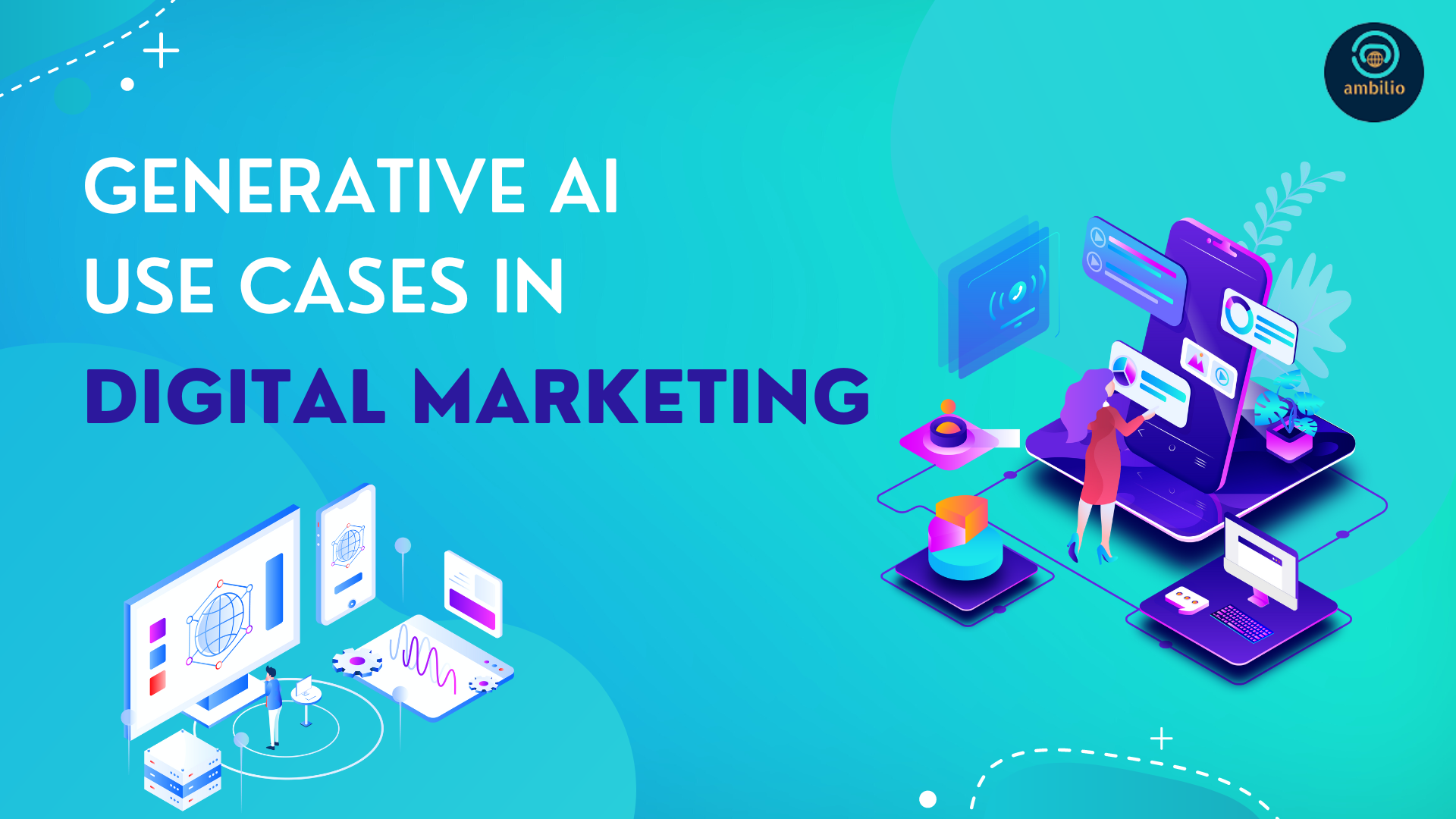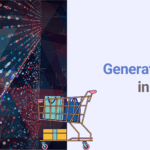Generative AI can be used in digital marketing to create personalized content for customers, such as customized product recommendations, social media posts, and email marketing campaigns. By analyzing customer data and behavior, generative AI can create highly targeted and relevant content that resonates with customers, increasing engagement and conversion rates. Additionally, generative AI can be used to create unique and compelling visual content, such as images and videos, which can be used to capture the attention of potential customers and increase brand awareness. Overall, generative AI has the potential to revolutionize digital marketing by improving customer engagement, increasing conversions, and streamlining content creation. We present here the key applications and use cases of generative AI in digital marketing.
Generative AI in Digital Marketing
Generative AI has several applications in digital marketing, including:
Personalized content creation
Generative AI can analyze customer data and behavior to create personalized content such as social media posts, product recommendations, and email marketing campaigns.
Creative visual content creation
Generative AI can be used to create unique visual content, including images and videos, that can be used to capture the attention of potential customers and increase brand awareness.
Chatbots and virtual assistants
Generative AI can be used to create chatbots and virtual assistants that can handle customer inquiries and provide personalized recommendations, improving customer service and increasing customer satisfaction.
A/B testing
Generative AI can be used to automate A/B testing, allowing marketers to quickly and efficiently test different marketing strategies and optimize their campaigns.
Predictive analytics
Generative AI can be used to analyze customer data and behavior to make predictions about future customer behavior, allowing marketers to create more effective and targeted campaigns.
Voice search optimization
Generative AI can be used to optimize content for voice search, which is becoming increasingly popular with the rise of virtual assistants like Siri and Alexa.
Content personalization
Generative AI can be used to create personalized content not only based on customer data, but also on real-time data such as weather, location, and social media trends.
Product design and customization
Generative AI can be used to design and customize products, allowing companies to create unique and personalized products that meet the specific needs of individual customers.
Fraud detection
Generative AI can be used to detect and prevent fraud in digital marketing, such as click fraud or fake reviews.
Social media monitoring
Generative AI can be used to monitor social media for mentions of a brand or product, allowing marketers to quickly respond to customer feedback and address any issues.
Overall, generative AI has the potential to transform digital marketing by improving customer engagement, increasing conversions, and streamlining content creation and optimization processes.
Use Case 1: Personalized content creation
Consider a fashion e-commerce website that wants to improve engagement and increase sales by creating personalized product recommendations for its customers. The website could use generative AI techniques such as collaborative filtering and natural language processing to analyze customer behavior and preferences.
Collaborative filtering is a technique that analyzes customer purchase history and identifies similar customer segments based on their behavior. For example, if many customers who purchase a specific type of dress also tend to purchase a particular type of shoe, the website can use collaborative filtering to recommend the shoes to other customers who have purchased the dress.
Natural language processing can also be used to analyze customer reviews and social media posts related to the products sold on the website. By analyzing the language and sentiment of these posts, the website can gain insights into how customers feel about different products, as well as what specific features and attributes they value most.
Based on this data, the website can use generative AI to create personalized product recommendations for each customer. For example, if a customer has previously purchased a dress and left a positive review mentioning the fit and comfort of the fabric, the website can recommend similar dresses with similar fabric types and fits.
The website can also use generative AI to create personalized messaging for its marketing campaigns. For example, if a customer has previously expressed an interest in eco-friendly products, the website can use natural language processing to analyze customer interactions and create messaging that highlights the eco-friendliness of the products they sell.
Overall, by leveraging generative AI techniques such as collaborative filtering and natural language processing, the fashion e-commerce website can create highly personalized product recommendations and marketing messaging that resonate with its customers and drive engagement and sales.
Use Case 2: Creative visual content creation
One of the most common use cases of generative AI in digital marketing is in the creation of images and videos. Traditionally, creating visual content can be a time-consuming and expensive process that requires a team of designers, photographers, and videographers. However, with generative AI, brands can create custom images and videos in a matter of seconds, using nothing more than a few keywords or a brief description of what they want to convey.
One technique used in generative AI for creative visual content creation is generative adversarial networks (GANs). GANs are a type of neural network that consists of two parts: a generator and a discriminator. The generator creates new images or videos, while the discriminator evaluates them and decides whether they are real or fake. Through a process of trial and error, the generator learns to create images or videos that are more and more realistic, while the discriminator becomes better at identifying fakes.
Another technique used in generative AI for creative visual content creation is style transfer. Style transfer involves taking the style of one image or video and applying it to another image or video. For example, a brand might take a photo of a sunset and apply the style of a famous painter to create a unique and eye-catching image. Style transfer can be used to create a wide range of visual content, from product shots to social media graphics.
One of the major benefits of using generative AI for creative visual content creation is that it allows brands to create custom content at scale. With traditional visual content creation methods, it can be difficult and expensive to create unique content for every campaign or platform. However, with generative AI, brands can create hundreds or even thousands of custom images or videos in a matter of hours, allowing them to target different audiences and platforms with tailored content.
In conclusion, generative AI has the potential to revolutionize visual content creation in digital marketing. By using techniques like GANs and style transfer, brands can create custom, engaging visual content at scale, helping them to stand out from the competition and connect with their audience in new and exciting ways.
Use Case 3: Product design and customization
One of the most significant applications of generative AI in digital marketing is product design and customization. Using generative AI techniques, businesses can create unique and personalized products that cater to individual customer preferences and needs.
One popular technique used in generative AI for product design and customization is Generative Adversarial Networks (GANs). GANs consist of two neural networks: a generator and a discriminator. The generator creates new samples, such as images or text, while the discriminator tries to differentiate between the generated samples and real samples. Over time, the generator improves by learning from the discriminator’s feedback, resulting in more realistic and accurate samples.
To apply GANs in product design and customization, businesses can use customer data to train the generator. For example, if a business sells custom-made clothing, they can use customer data such as measurements, style preferences, and color choices to train the generator. The generator can then create unique designs that match each customer’s preferences. This not only enhances the customer experience by providing them with a personalized product, but it also streamlines the design process for the business.
Another technique used in generative AI for product design and customization is Variational Autoencoders (VAEs). VAEs are neural networks that learn a compact representation of input data, such as images or text. This representation can then be used to generate new samples that are similar to the input data. VAEs can be trained on customer data to generate personalized product designs that match the customer’s preferences.
To apply VAEs in product design and customization, businesses can use customer data to train the VAE. For example, if a business sells custom-made furniture, they can use customer data such as room dimensions, color schemes, and style preferences to train the VAE. The VAE can then generate furniture designs that match the customer’s preferences and fit their specific room dimensions.
Generative AI techniques can also be used to enhance product visualization for customers. For example, businesses can use generative AI to create 3D product models that customers can interact with and customize in real-time. This enables customers to see exactly what their personalized product will look like before making a purchase. This enhances the customer experience by providing them with a visual representation of their personalized product, and it can also increase customer confidence in their purchase decision.
In conclusion, generative AI has significant applications in digital marketing for product design and customization. Using techniques such as GANs and VAEs, businesses can create personalized products that cater to individual customer preferences and needs. Generative AI techniques also enable businesses to enhance product visualization for customers, providing them with a visual representation of their personalized product before making a purchase. These applications of generative AI not only enhance the customer experience but also streamline the design process for businesses.
Use Case 4: Social media monitoring
One area where generative AI has gained significant traction is social media monitoring. With the vast amounts of data generated on social media platforms, businesses can use generative AI techniques to analyze and monitor social media data to gain valuable insights into customer behavior, sentiment, and preferences.
One popular technique used in generative AI for social media monitoring is Natural Language Processing (NLP). NLP is a branch of AI that focuses on the interaction between computers and humans through natural language. NLP techniques can be used to analyze and understand social media posts, comments, and messages, providing businesses with valuable insights into customer behavior and preferences.
To apply NLP in social media monitoring, businesses can use sentiment analysis. Sentiment analysis is a technique that uses NLP to determine the sentiment of social media posts, comments, and messages. Sentiment analysis can be used to analyze social media data to identify the mood of customers, such as positive, negative, or neutral. This enables businesses to identify potential issues and respond promptly to customer complaints, improving customer satisfaction.
Another popular technique used in generative AI for social media monitoring is machine learning. Machine learning is a type of AI that enables computers to learn from data without being explicitly programmed. Machine learning algorithms can be trained on social media data to identify patterns and trends, providing businesses with valuable insights into customer behavior.
To apply machine learning in social media monitoring, businesses can use clustering analysis. Clustering analysis is a technique that groups similar data points together based on their characteristics. Businesses can use clustering analysis to group social media posts and comments based on their content, providing insights into customer preferences and behavior. This enables businesses to identify trends and patterns in customer behavior, enabling them to tailor their marketing strategies to the specific needs and preferences of their customers.
Generative AI techniques can also be used to monitor social media for brand mentions and conversations related to specific products or services. For example, businesses can use generative AI to monitor social media conversations related to their brand, identifying positive or negative sentiments towards their products or services. This enables businesses to respond promptly to customer feedback and address any issues, improving customer satisfaction.
In conclusion, generative AI techniques such as NLP and machine learning have significant applications in social media monitoring for digital marketing. Businesses can use these techniques to analyze social media data to gain valuable insights into customer behavior, sentiment, and preferences. This enables businesses to tailor their marketing strategies to the specific needs and preferences of their customers, improving customer satisfaction and driving business growth.
Use Case 5: Chatbots and virtual assistants
Generative AI has become an essential tool for businesses to improve their customer experience and enhance their digital marketing efforts. One area where generative AI has gained significant traction is chatbots and virtual assistants. With the growing demand for 24/7 customer support and personalized interactions, chatbots and virtual assistants are becoming an integral part of digital marketing strategies.
One popular technique used in generative AI for chatbots and virtual assistants is natural language generation (NLG). NLG is a technique that uses machine learning algorithms to generate human-like text from structured data. NLG can be used to create personalized responses to customer inquiries, providing a seamless customer experience.
To apply NLG in chatbots and virtual assistants, businesses can use a rule-based approach. This approach involves creating a set of rules that determine the response of the chatbot or virtual assistant to specific customer inquiries. These rules can be customized to address the specific needs and preferences of customers, enabling businesses to provide personalized interactions and improve customer satisfaction.
Another popular technique used in generative AI for chatbots and virtual assistants is natural language understanding (NLU). NLU is a technique that uses machine learning algorithms to understand the intent behind customer inquiries. NLU can be used to identify the keywords and phrases in customer inquiries and map them to specific actions, enabling businesses to provide relevant responses to customer inquiries.
To apply NLU in chatbots and virtual assistants, businesses can use intent recognition. Intent recognition is a technique that uses NLU to identify the intent behind customer inquiries. This enables chatbots and virtual assistants to provide relevant responses to customer inquiries, improving the customer experience and driving business growth.
Generative AI techniques can also be used to create personalized recommendations and offers for customers. For example, businesses can use generative AI to analyze customer data and identify their preferences and behavior. This enables businesses to create personalized offers and recommendations that are tailored to the specific needs and preferences of their customers, improving customer satisfaction and loyalty.
In conclusion, generative AI techniques such as NLG and NLU have significant applications in chatbots and virtual assistants for digital marketing. Businesses can use these techniques to create personalized interactions with customers, provide relevant responses to customer inquiries, and create personalized offers and recommendations. This enables businesses to improve customer satisfaction and drive business growth, making chatbots and virtual assistants an essential part of any digital marketing strategy.



